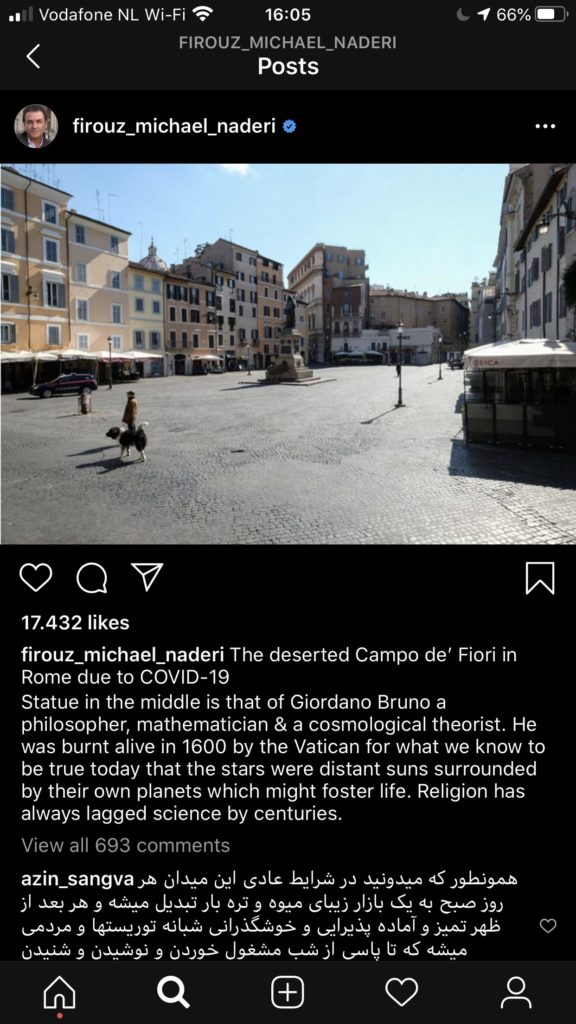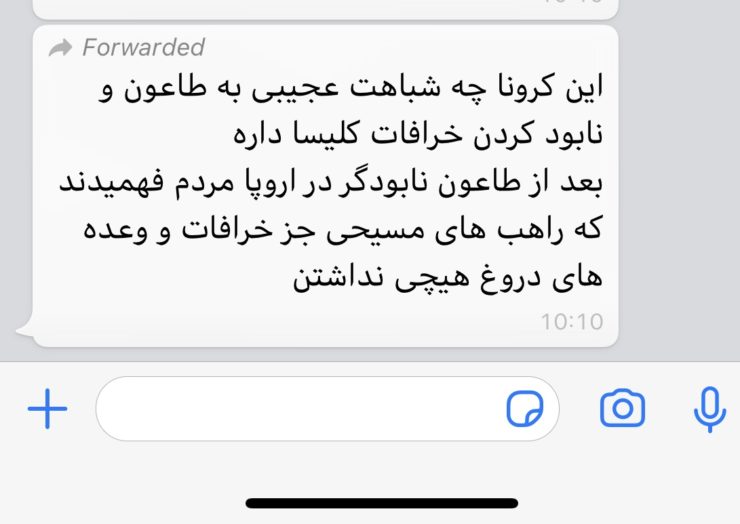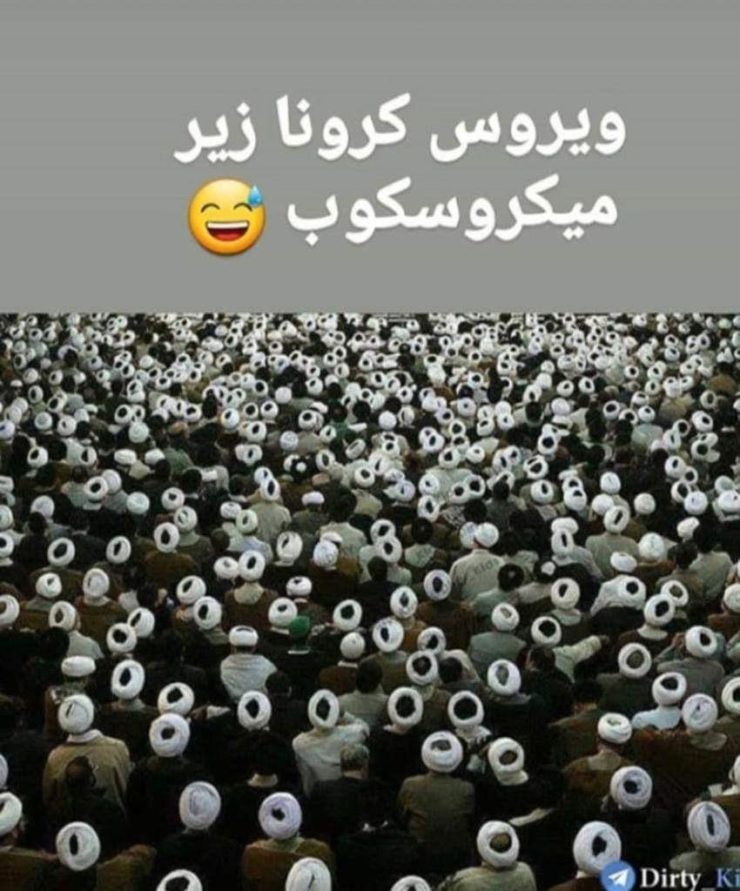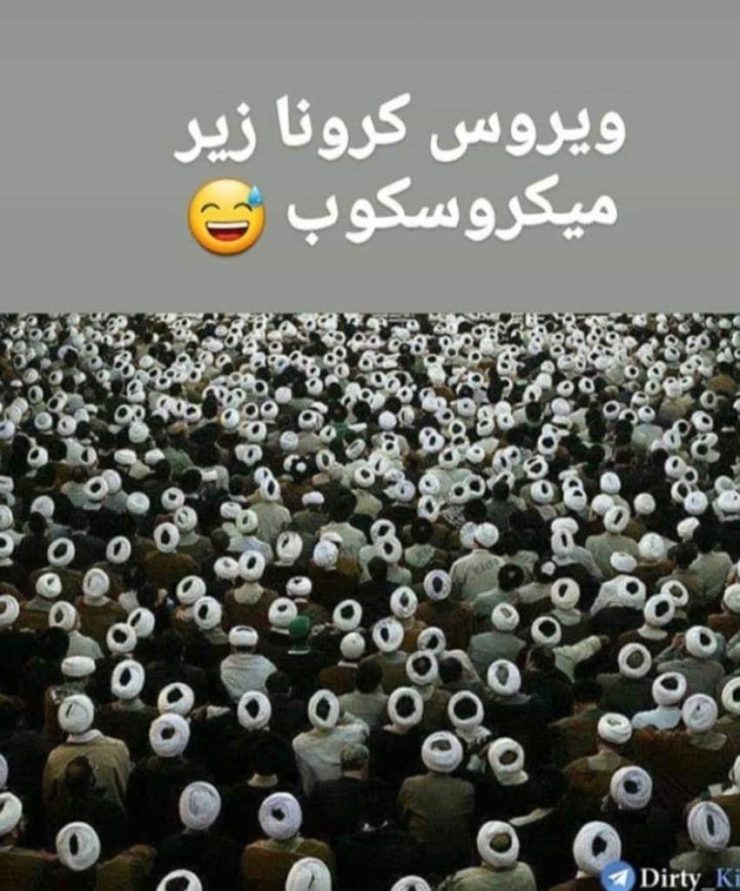The Coronavirus pandemic illustrates the contemporary entanglement of religion, science, and politics. The many opinion pieces, analyses, and news items published about the role and response of religions in countries as different as the United States and India remind us that we need to research religions as part of a globalized world, next to taking into account national peculiarities. The Islamic Republic of Iran is a case in point. The virus hit the country hard, in the early stage of the outbreak especially in the holy city of Qum. The crisis deepens a nation already in turmoil, facing crippling economic sanctions and widespread protests against the theocratic regime that were silenced only by brutal state-organized killings. At this moment, the Coronavirus brings out and sharpens the divides that already characterize Iran.
One way to interpret these divides is through the lens of recent secularization theory, as we know from sociologist José Casanova’s Public Religions in the Modern World (1994) onwards. The coronavirus pandemic can be said to mediate the secularization of Iranian attitudes in two fundamental ways. First, it deepens citizens’ already prevalent anti-theocratic political attitudes. Secondly, it sharpens epistemological differentiation between Islam and the natural sciences. Recalling Casanova, in Public Religions these two were understood – the formation of the modern state and the early modern scientific revolution – as essential to the differentiation process, though not exclusively, that characterizes European secularization. Put otherwise, political liberalization and secularization occurred in response to absolutist “caesaropapism,” where worldly power’s fusion with sacred authority proved to be a self-defeating endeavor, while epistemological secularization came to separate the domains of knowledge shared by religion and science – the Book of God ceded prominence to the natural sciences’ independent Book of Nature.
When Casanova wrote Public Religions, he mentioned the Iranian revolution to exemplify the falsity of teleological narratives of secularization (1994: 3, 10, 225), albeit without including a chapter on the country. Indeed, secularization is not a necessary or unidirectional historical phenomenon. It is a multidimensional process dependent on “contingent” (Idem.: 43) historical trajectories. That does not take away from the fact, however, that contemporary Iran does show significant family resemblances to Casanova’s analysis of European history. As Casanova clarified at the time: “I do not think, however, that non-Western cultures are “the other”” (Idem.: 10). Moreover, the West has long exerted power on and influenced Iranians. The historian Amir Afkhami describes in A Modern Contagion: Imperialism and Public Health in Iran’s Age of Cholera (2019) how outbreaks of cholera in the 19th century escalated the need for modern, European medicine, made available with the establishment of the Dar al Funun Polytechnique college, or House of Techniques, in Tehran. Today, western governments, historical narratives, and scientific knowledge continue to exercise considerable influence on Iranians’ self-understanding and attitudes regarding the relationship between state and religion, and between science and religion.
We can understand the Coronavirus as a catalyst for the secularization of Iranian attitudes by analyzing the visual culture and discourses that go viral on the Internet. In a recent unpublished paper by one of our research master students, Rashmi Shetty, titled “Understanding Delegitimatization of Religion in Internet Memes,” she proposes a methodology that underscores the importance of social media and especially memes in studying non-religion (2020). Internet memes’ multimodal discourse, their replicability and flexibility, their participatory culture and polyvocality, and their unrestrictedness and anonymity, she explains, all contribute to the rhetorical effect of delegitimizing religions. This is unmistakeably so in Iran, where the combination of violent information censoring with Internet availability in all provinces caused social media practices to acquire a unique form. WhatsApp, for instance, is not a simple messaging tool but is handled in much the same way as Europeans and Americans use a Facebook wall. Entire families and friend-groups send each other hundreds of semi-private messages on a daily basis. An interpretation of digital visual culture and discourses will produce a partially distorted image of Iranians’ attitudes. The same goes for gathering data through anonymous digital surveys. The problem of bias, especially in a semi-totalitarian context, however, does not mean that we can do without studying digital (non-)religion, for the Internet is an essential location of relatively open expressions. It is crucial to consider that an estimated 57 of 81 million Iranians are Internet users, almost 50 million of whom are active social media users, and around 40 million of whom have access to social media on cellphones (for sources see GAMAAN 2019). It is unsurprising, therefore, that the first mass uprising in the world organized thanks to Twitter happened in Iran after the controversial 2009 presidential elections and the rise of the so-called Green Movement. That is also why a total Internet shutdown was deemed necessary by the state in 2019, as a prerequisite for stopping widespread street protests.
We should hence bear in mind that Internet penetration in Iran is high, that the state employs it for surveillance, but also that people turn to semi-public and public social media to share the daily news, political commentary, and jokes. In a survey conducted by GAMAAN on the Coronavirus between March 15-20, 2020, respondents were asked through which media they followed the pandemic. Almost 30% said they watched the Islamic Republic’s state television, while slightly over 30% (also) ticked the option of foreign television channels such as BBC Persian and ManotoTV. A massive 80%, however, reported using social media such as Telegram, Instagram, and WhatsApp for newsgathering. The latter percentage is inevitably high because the survey was conducted online. Nonetheless, it corresponds with the increasing use of social media over television channels, which are not obsolete but watched in combination with millions of Internet users’ input.
Digital qualitative research of Iranian attitudes on politics, science, and religion can analyze the shared short video’s, pictures, texts, and memes that combine images with short persuasive captions. I briefly give examples of each of these material-types below.
A video of Ayatollah Khomeini, first shared by ManotoTV, went viral in Iranian social media in response to the Coronavirus crisis. The English subtitles in the uploaded version shown here were added by myself:
Video shared with WhatsApp and Telegram, March 2020.
One may object to such a video that it takes Khomeini’s words out of context. They were uttered in the era of the Islamic Revolution, the Iran-Iraq war of the 1980s, and the subsequent Cultural Revolution that purged the universities from academics thought to be insufficiently Islamic. That is, though, precisely intended by those who share the video in the current crisis, to link Khomeinism to Iran’s decades-long brain drain rhetorically. The founder of the Islamic Republic is blamed along these lines for creating the conditions under which the country is overwhelmed by the Coronavirus today. Whether this is an accurate representation or a fair analysis, does not concern me here. What matters, in any case, is that ordinary people swiftly associate the shocking spread of the Coronavirus in Iran with a bitter conflict between theocratic governance and modern university knowledge. This mainstream attitude, in spite of its frivolity, falls into a much older historical trajectory in which universities such as the Dar al Funun and later the University of Tehran stood in sharp political and epistemic contrast with the clerical establishment. The sharing of Khomeini’s speech is thus in line with the summary analysis of the paradoxes of sovereignty given by anthropologist Ziba Mir Hosseini (2017). She argues, as Casanova did for Europe, that the theocratic state’s involvement in worldly affairs has, by logical implication and by historical fact, exposed it to critiques of political religion. Her overview is confirmed by GAMAAN’s 2019 survey on the very idea of the Islamic Republic, conducted on the occasion of the regime’s 40th anniversary. The results, based on a sample size of 180,000 residing in Iran, show that in a free referendum, approximately 80% would vote NO to the theocratic system.
The societal relations between secular knowledge and Islamic institutions are a complicated matter comprised of various entanglements between science and reason, spirituality and Islam, social conditions, and politics. The anthropologist Alireza Doostdar offers a framework for thinking through these entanglements in The Iranian Metaphysicals: Explorations in Science, Islam, and the Uncanny (2018). His ethnographic research on occult beliefs and practices in contemporary urban Iran shows that divides between the secular, the spiritual, and Islam are not as clearcut as is sometimes believed. Important for western audiences, which may be prone to assume otherwise, is that he explains the popularity of the language of science among Iranian believers and that the state has historically deployed rhetorical strategies and punishment policies to distance itself from “khurafat” or superstition. One should be careful, therefore, not to simply equate American Biblebelt anti-science stances with Iranian Shi’ite attitudes towards the natural sciences in the 20th and 21st centuries. Doostdar’s account thus contributes to the anthropology of religion, yet is so concentrated on deconstructing divides between the secular and the religious, that he underreports the general political critique of theocratic governance as well as the overall historical differentiation of science and Islam, which has led to fundamental epistemic disentanglements. The ethnographic narrative thus tends to offer a rather exotic image of “Iranian metaphysicals,” which may be attractive to western academics bent on self-critique but comes at the cost of downplaying the gargantuan impact of secularization and the associated conflict with traditional forms of knowledge—and not in continuity with those forms as Doostdar believes. By Doostdar’s account, the Iranian state itself is pro-science in its attacks on today’s perceived superstitious and occult practices. However, the distinction between Islam and superstition is not accepted by the many who collapse the critique of the one into the other.
Social media serve the clash between religion and science because they hide the complexity unraveled by a scholar like Doostdar. Social media, instead, package critiques to achieve a maximum contrast effect. Take, for instance, an Instagram post by Firouz Naderi, famous among Iranians for his prestigious leadership at NASA. During the Coronovirus crisis, on March 26th, he posted a picture of a deserted Campo de’ Fiori in Rome due to COVID-19, with a caption summing up the life and execution of Giordano Bruno whose statue stands on the square. The text concludes, unequivocally, that “Religion has always lagged behind science by centuries.” Naderi’s predominantly Iranian followers liked the post 17 thousand times in two days and left hundreds of supportive comments in Persian worth a full discourse analysis in themselves.

Such posts resonate with texts, often jokes, sent uninterruptedly in Iranian WhatsApp groups and Telegram channels. In one of these, we read, “This Corona shows an uncanny resemblance to the plague and elimination of church superstitions [khurafat kilisa]. After being ravished by the plague, the people of Europe understood that Christian monks offered nothing but deceitful promises.”

These texts often link and authorize a critique of the Iranian context and Islam by way of imagined European histories. They also follow simply from Europe being central to intellectual and historical knowledge production in Iran.
Simultaneously, as Doostdar explains, the Islamic Republic itself does not want to appear unscientific. It has, for instance, arrested the eyebrow-raising lickers of the Shrine of Fatima Masumeh, Imam Reza’s sister, and charged them with conducting superstitious acts (which should be distinguished from Islam properly understood, which is in accordance with reason, aql, and thus in accordance with science, ilm). This is merely one way in which the regime maintains its positive stance towards natural science and modern medicine. And yet, the strategy to separate Islam properly understood from superstition can be hardly described as successful. Because of the theocratic regime’s lack of political legitimacy, the virus appears as one more opportunity to condemn religions in general as unscientific and superstitious in numerous posts targeting the clerical class. These sentiments were only encouraged when Ayatollah Khamenei, the Supreme Leader, went on television to suggest that the Americans may have secretly produced COVID-19, but also that the biological weapon “is specifically built for [attacking] Iran using the genetic data of Iranians.” Unsurprisingly, Internet users responded with indignation and general remarks about these politically motivated delusions, the establishment’s failure to engage in rational debate and to produce trustworthy information about the pandemic. GAMAAN’s latest survey on the Coronavirus confirms the common sentiment, with a cleaned sample size of roughly 15,000 residing in Iran, and weighted for sex, age, education level, and regional distribution. A whopping 60% said they have “very little” and 15% “little” trust in the state’s handling of the disease, while over 90% said that they would or do agree with quarantining cities. The overwhelming majority of the population also stated to have taken preventive measures, such as washing their hands with soap and water or practicing social distancing (not attending gatherings, parties, keeping a distance from others). In other words, a focus on the few who dramatically persevere in their faith and continue to visit or seek to visit mausolea in Qum or Mashhad is hardly representative of the overwhelming majority that trusts scientific evidence over religious promises of healing. Ethnographic attention to believers’ flocking to holy shrines and mausolea risks exaggerating Iranian irrationality before international audiences and should be balanced by social scientific comparison with the general populace. Those in Iran who are worried about the situation, who may believe or not and who do not make the headlines, are sitting at home looking at their cellphones just like any other people in affected countries such as China, Italy, or the United States.
The material entanglements of a virus, religion, science, and politics, therefore, force a conceptual disentanglement of religion and science that is influenced by political visions of the clerical class as the real threat. This is exemplified by one of the memes that circulated in response to the outbreak in Qum, in which the mullahs themselves are depicted as the Coronavirus:

The meme-text is “Coronavirus under a microscope,” accompanied by an embarrassed smiley, which guides the viewers to visually conflate a large gathering of turban-wearing clerics with supposedly viruslike cellular structures.
In this post, I presented examples of the digital materials that can be qualitatively analyzed in digital studies of secular political attitudes and epistemic secularization in Iran, and which can be best framed and interpreted by also using quantitative, ethnographic, and historical inquiries. A larger sample should be obviously used in a thorough analysis of videos, social media posts, texts, and memes. Plus, it remains the case that the Iranian revolution long functioned to debunk teleological modernization fantasies. If mostly western-based academics continue to reproduce a narrative of secularization as exceptionally European, however, they will fail to come to terms with the fundamental contingency of such global developments. Casanova himself, despite expanding his latest views on secularization and pluralization to countries as different as Ukraine, China, and India, but not Iran, still goes on to distinguish Europe from “the rest of the world” (2019: 3, 11, 16, 34). A different approach would recognize that an object such as the Coronavirus is so vastly connected to global industries, political formations, and information networks, that the antiquated Europe-Rest dichotomy is doomed to fail to explain various religions’ responses to this pandemic. Moreover, in some contexts, like Iran, it is likely that the Coronavirus only deepens secularization in the two senses outlined above. All of this is, of course, a far cry from conceiving of religion as a matter of personal beliefs, or as constituted by the practices of a relatively bounded community. Iran, in this sense, is merely one more country on a connected planet, for better and for worse.
References
– Afkhami, Amir A. 2019. A Modern Contagion: Imperialism and Public Health in Iran’s Age of Cholera. Baltimore: Johns Hopkins University Press.
– Casanova, José V. 1994. Public religions in the modern world. Chicago: The University of Chicago Press.
– Casanova, José. 2019. Global Religious and Secular Dynamics The Modern System of Classification. Brill Research Perspectives on Religion and Politics, online publication.
– Doostdar, Alireza. 2018. The Iranian Metaphysicals: Explorations in Science, Islam, and the Uncanny. Princeton & Oxford: Princeton University Press.
– GAMAAN. 2019. Survey Report on “The Islamic Republic: Yes or No” (English translation). Published online, gamaan.org.
– GAMAAN. 2020. گزارش نظرسنجی دربارهبیماری کرونا در ایران (Survey report on the Coronavirus in Iran; English translation of the summary is forthcoming). Published online, gamaan.org.
– Mir-Hosseini, Ziba. 2017. “Islam, Gender, and Democracy in Iran,” in Islam, Gender, and Democracy in Comparative Perspective, edited by Jocelyne Cesari and José Casanova. New York and Oxford: Oxford University Press, Ch. 9.
– Shetty, Rashmi. 2020 (unpublished student paper). Understanding Delegitimatization of Religion in Internet Memes. Utrecht University.
This blog is a part of ‘Dossier Corona’, introduced by Religious Matters in the spring of 2020.


